TOYOTA SIENNA 2007 Service Repair Manual
Manufacturer: TOYOTA, Model Year: 2007, Model line: SIENNA, Model: TOYOTA SIENNA 2007Pages: 3000, PDF Size: 52.26 MB
Page 501 of 3000
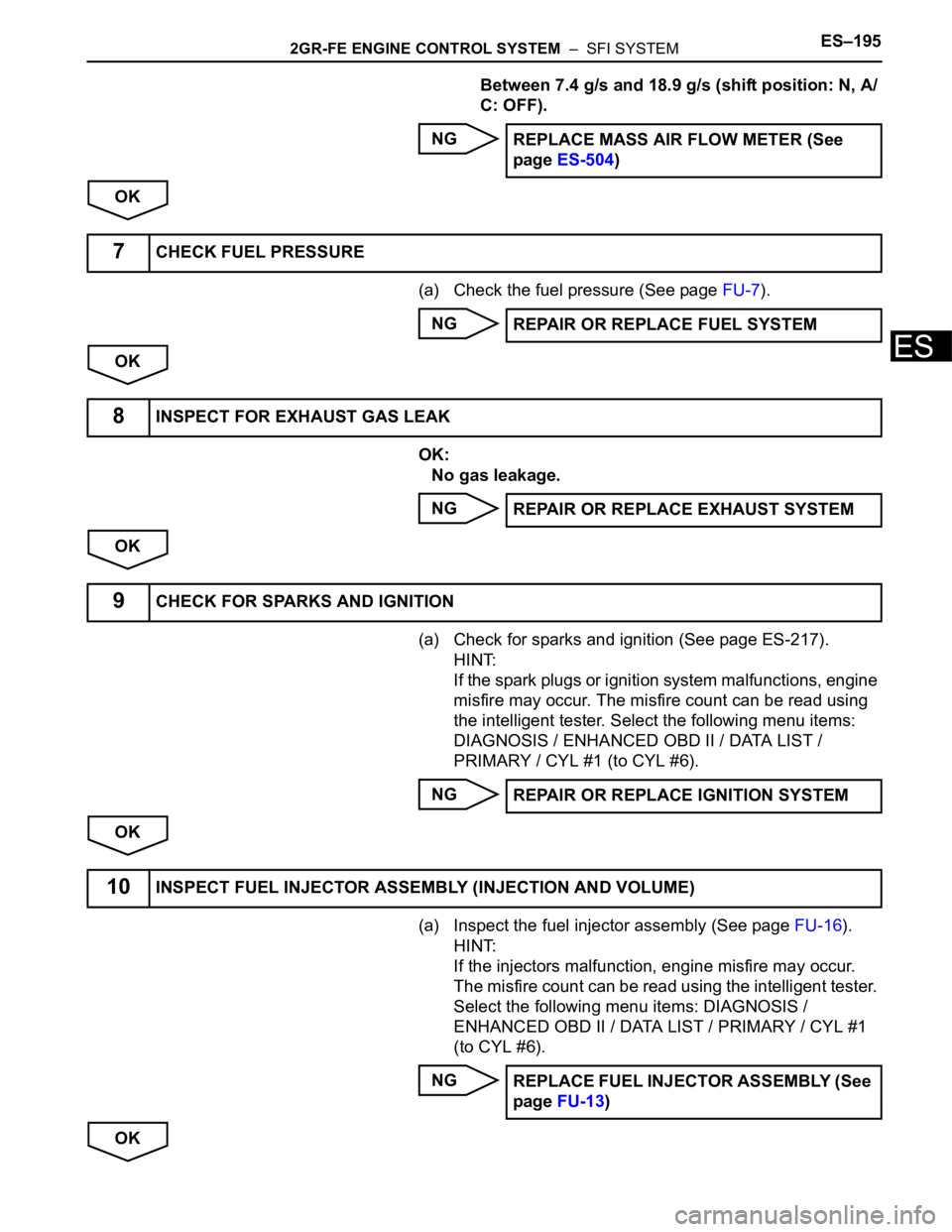
2GR-FE ENGINE CONTROL SYSTEM – SFI SYSTEMES–195
ES
Between 7.4 g/s and 18.9 g/s (shift position: N, A/
C: OFF).
NG
OK
(a) Check the fuel pressure (See page FU-7).
NG
OK
OK:
No gas leakage.
NG
OK
(a) Check for sparks and ignition (See page ES-217).
HINT:
If the spark plugs or ignition system malfunctions, engine
misfire may occur. The misfire count can be read using
the intelligent tester. Select the following menu items:
DIAGNOSIS / ENHANCED OBD II / DATA LIST /
PRIMARY / CYL #1 (to CYL #6).
NG
OK
(a) Inspect the fuel injector assembly (See page FU-16).
HINT:
If the injectors malfunction, engine misfire may occur.
The misfire count can be read using the intelligent tester.
Select the following menu items: DIAGNOSIS /
ENHANCED OBD II / DATA LIST / PRIMARY / CYL #1
(to CYL #6).
NG
OKREPLACE MASS AIR FLOW METER (See
page ES-504)
7CHECK FUEL PRESSURE
REPAIR OR REPLACE FUEL SYSTEM
8INSPECT FOR EXHAUST GAS LEAK
REPAIR OR REPLACE EXHAUST SYSTEM
9CHECK FOR SPARKS AND IGNITION
REPAIR OR REPLACE IGNITION SYSTEM
10INSPECT FUEL INJECTOR ASSEMBLY (INJECTION AND VOLUME)
REPLACE FUEL INJECTOR ASSEMBLY (See
page FU-13)
Page 502 of 3000
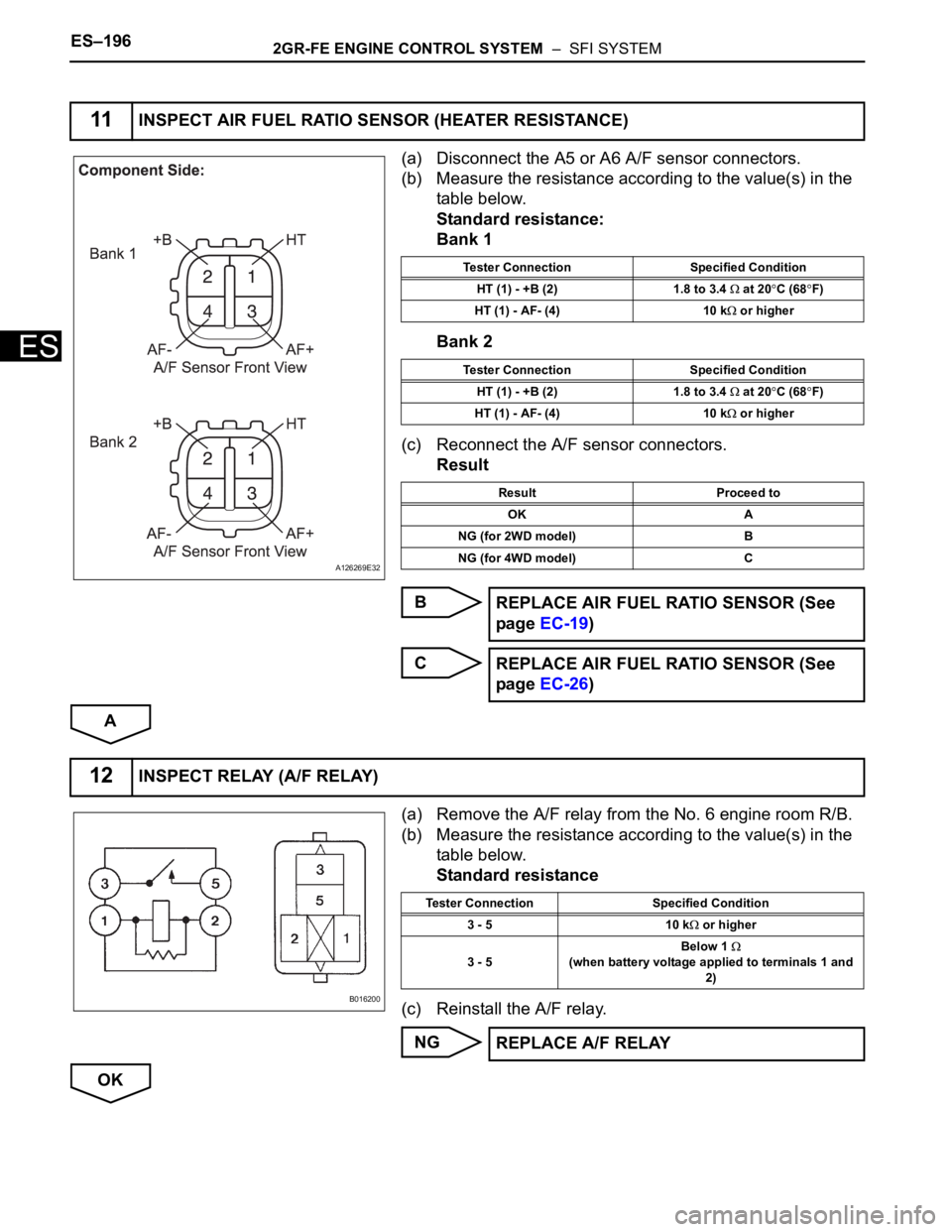
ES–1962GR-FE ENGINE CONTROL SYSTEM – SFI SYSTEM
ES
(a) Disconnect the A5 or A6 A/F sensor connectors.
(b) Measure the resistance according to the value(s) in the
table below.
Standard resistance:
Bank 1
Bank 2
(c) Reconnect the A/F sensor connectors.
Result
B
C
A
(a) Remove the A/F relay from the No. 6 engine room R/B.
(b) Measure the resistance according to the value(s) in the
table below.
Standard resistance
(c) Reinstall the A/F relay.
NG
OK
11INSPECT AIR FUEL RATIO SENSOR (HEATER RESISTANCE)
A126269E32
Tester Connection Specified Condition
HT (1) - +B (2) 1.8 to 3.4
at 20C (68F)
HT (1) - AF- (4) 10 k
or higher
Tester Connection Specified Condition
HT (1) - +B (2) 1.8 to 3.4
at 20C (68F)
HT (1) - AF- (4) 10 k
or higher
Result Proceed to
OK A
NG (for 2WD model) B
NG (for 4WD model) C
REPLACE AIR FUEL RATIO SENSOR (See
page EC-19)
REPLACE AIR FUEL RATIO SENSOR (See
page EC-26)
12INSPECT RELAY (A/F RELAY)
B016200
Tester Connection Specified Condition
3 - 5 10 k
or higher
3 - 5Below 1
(when battery voltage applied to terminals 1 and
2)
REPLACE A/F RELAY
Page 503 of 3000
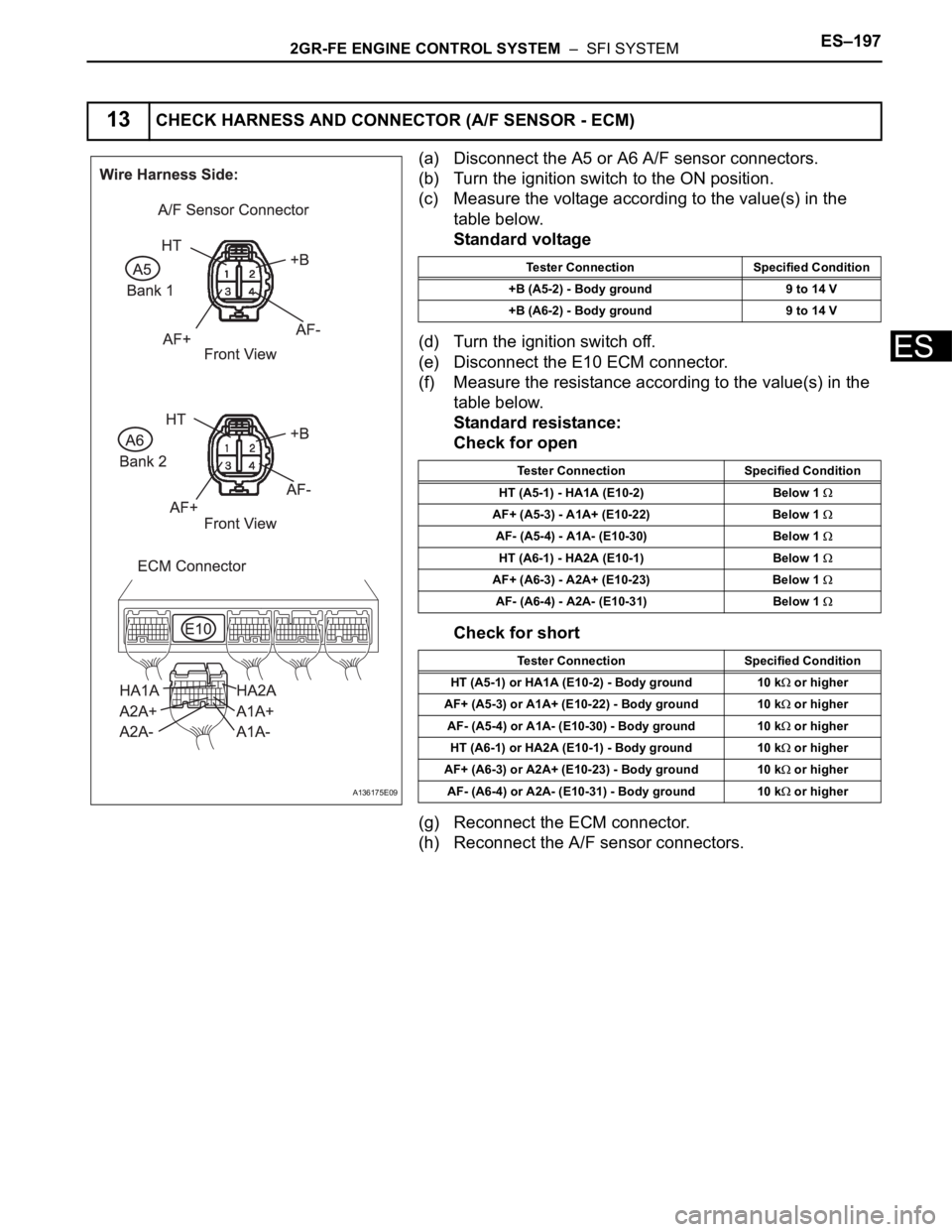
2GR-FE ENGINE CONTROL SYSTEM – SFI SYSTEMES–197
ES
(a) Disconnect the A5 or A6 A/F sensor connectors.
(b) Turn the ignition switch to the ON position.
(c) Measure the voltage according to the value(s) in the
table below.
Standard voltage
(d) Turn the ignition switch off.
(e) Disconnect the E10 ECM connector.
(f) Measure the resistance according to the value(s) in the
table below.
Standard resistance:
Check for open
Check for short
(g) Reconnect the ECM connector.
(h) Reconnect the A/F sensor connectors.
13CHECK HARNESS AND CONNECTOR (A/F SENSOR - ECM)
A136175E09
Tester Connection Specified Condition
+B (A5-2) - Body ground 9 to 14 V
+B (A6-2) - Body ground 9 to 14 V
Tester Connection Specified Condition
HT (A5-1) - HA1A (E10-2) Below 1
AF+ (A5-3) - A1A+ (E10-22) Below 1
AF- (A5-4) - A1A- (E10-30) Below 1
HT (A6-1) - HA2A (E10-1) Below 1
AF+ (A6-3) - A2A+ (E10-23) Below 1
AF- (A6-4) - A2A- (E10-31) Below 1
Tester Connection Specified Condition
HT (A5-1) or HA1A (E10-2) - Body ground 10 k
or higher
AF+ (A5-3) or A1A+ (E10-22) - Body ground 10 k
or higher
AF- (A5-4) or A1A- (E10-30) - Body ground 10 k
or higher
HT (A6-1) or HA2A (E10-1) - Body ground 10 k
or higher
AF+ (A6-3) or A2A+ (E10-23) - Body ground 10 k
or higher
AF- (A6-4) or A2A- (E10-31) - Body ground 10 k
or higher
Page 504 of 3000
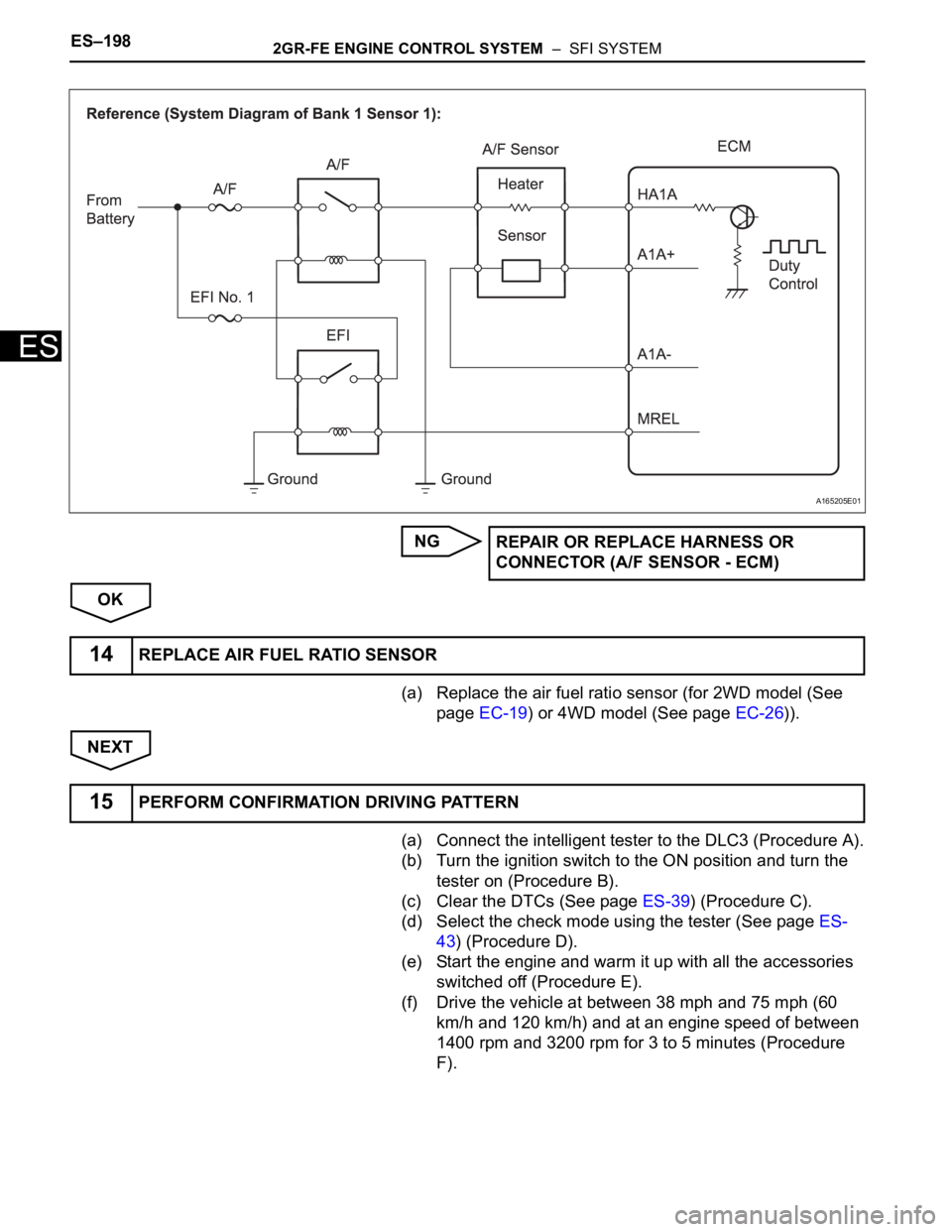
ES–1982GR-FE ENGINE CONTROL SYSTEM – SFI SYSTEM
ES
NG
OK
(a) Replace the air fuel ratio sensor (for 2WD model (See
page EC-19) or 4WD model (See page EC-26)).
NEXT
(a) Connect the intelligent tester to the DLC3 (Procedure A).
(b) Turn the ignition switch to the ON position and turn the
tester on (Procedure B).
(c) Clear the DTCs (See page ES-39) (Procedure C).
(d) Select the check mode using the tester (See page ES-
43) (Procedure D).
(e) Start the engine and warm it up with all the accessories
switched off (Procedure E).
(f) Drive the vehicle at between 38 mph and 75 mph (60
km/h and 120 km/h) and at an engine speed of between
1400 rpm and 3200 rpm for 3 to 5 minutes (Procedure
F).
A165205E01
REPAIR OR REPLACE HARNESS OR
CONNECTOR (A/F SENSOR - ECM)
14REPLACE AIR FUEL RATIO SENSOR
15PERFORM CONFIRMATION DRIVING PATTERN
Page 505 of 3000
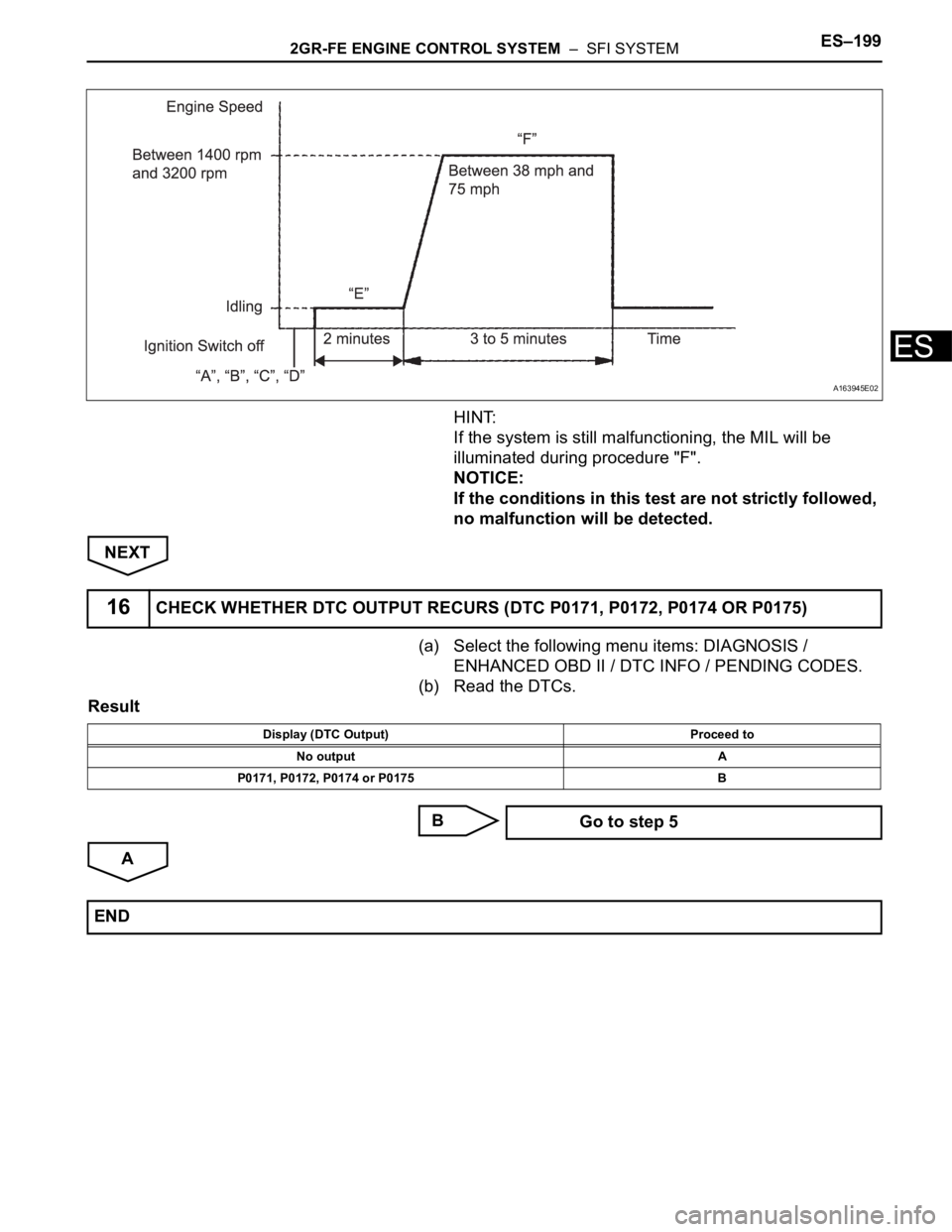
2GR-FE ENGINE CONTROL SYSTEM – SFI SYSTEMES–199
ES
HINT:
If the system is still malfunctioning, the MIL will be
illuminated during procedure "F".
NOTICE:
If the conditions in this test are not strictly followed,
no malfunction will be detected.
NEXT
(a) Select the following menu items: DIAGNOSIS /
ENHANCED OBD II / DTC INFO / PENDING CODES.
(b) Read the DTCs.
Result
B
A
A163945E02
16CHECK WHETHER DTC OUTPUT RECURS (DTC P0171, P0172, P0174 OR P0175)
Display (DTC Output) Proceed to
No output A
P0171, P0172, P0174 or P0175 B
Go to step 5
END
Page 506 of 3000

ES–2002GR-FE ENGINE CONTROL SYSTEM – SFI SYSTEM
ES
DESCRIPTION
• This DTC is designed to detect a malfunction in the fuel pump (FUEL PUMP) relay circuit. When the
system is normal, the battery voltage is applied to FPR terminal of the ECM while the FUEL PUMP
relay is turned OFF. If the battery voltage is not applied to the FPR terminal while the FUEL PUMP
relay is OFF, the ECM interprets this as a malfunction. The ECM then illuminates the MIL and sets a
DTC.
• The FUEL PUMP relay switches the fuel pump speed according to the engine conditions. The fuel
pump operates when the ECM receives the starter-operating signal (STA) and crankshaft-rotating
signal (NE). The FUEL PUMP relay is turned ON while the engine is idling or operating at low load.
This causes current to flow through the fuel pump resistor to the fuel pump. The fuel pump then
operates at low speed. The FUEL PUMP relay is turned OFF while the engine is cranking or operating
at high load. The fuel pump then operates at normal speed.
DTC P0230 Fuel Pump Primary Circuit
DTC No. DTC Detection Condition Trouble Area
P0230Open or short in FUEL PUMP relay circuit (1 trip
detection logic)• Open or short in FUEL PUMP relay circuit
• FUEL PUMP relay
•ECM
Page 507 of 3000
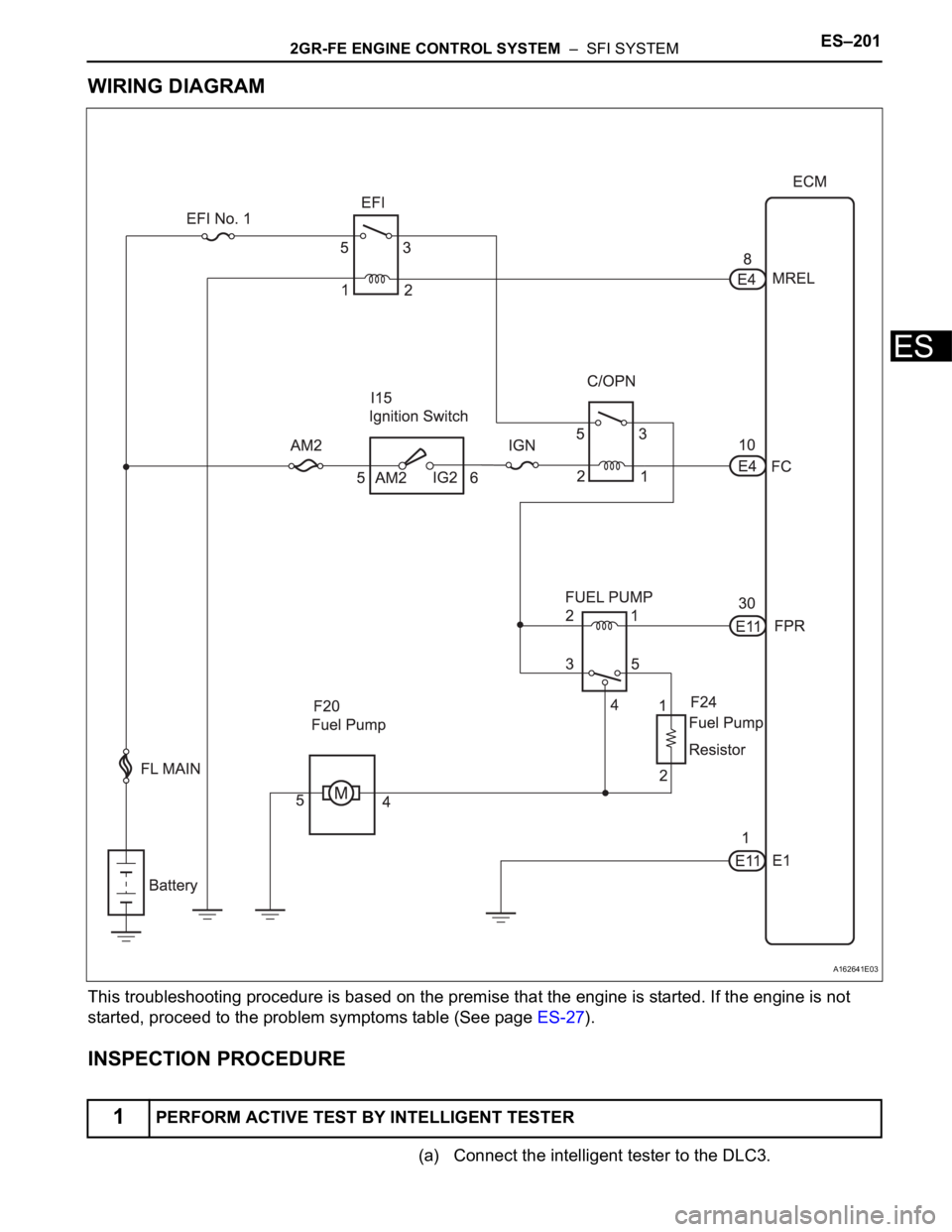
2GR-FE ENGINE CONTROL SYSTEM – SFI SYSTEMES–201
ES
WIRING DIAGRAM
This troubleshooting procedure is based on the premise that the engine is started. If the engine is not
started, proceed to the problem symptoms table (See page ES-27).
INSPECTION PROCEDURE
(a) Connect the intelligent tester to the DLC3.
1PERFORM ACTIVE TEST BY INTELLIGENT TESTER
A162641E03
Page 508 of 3000
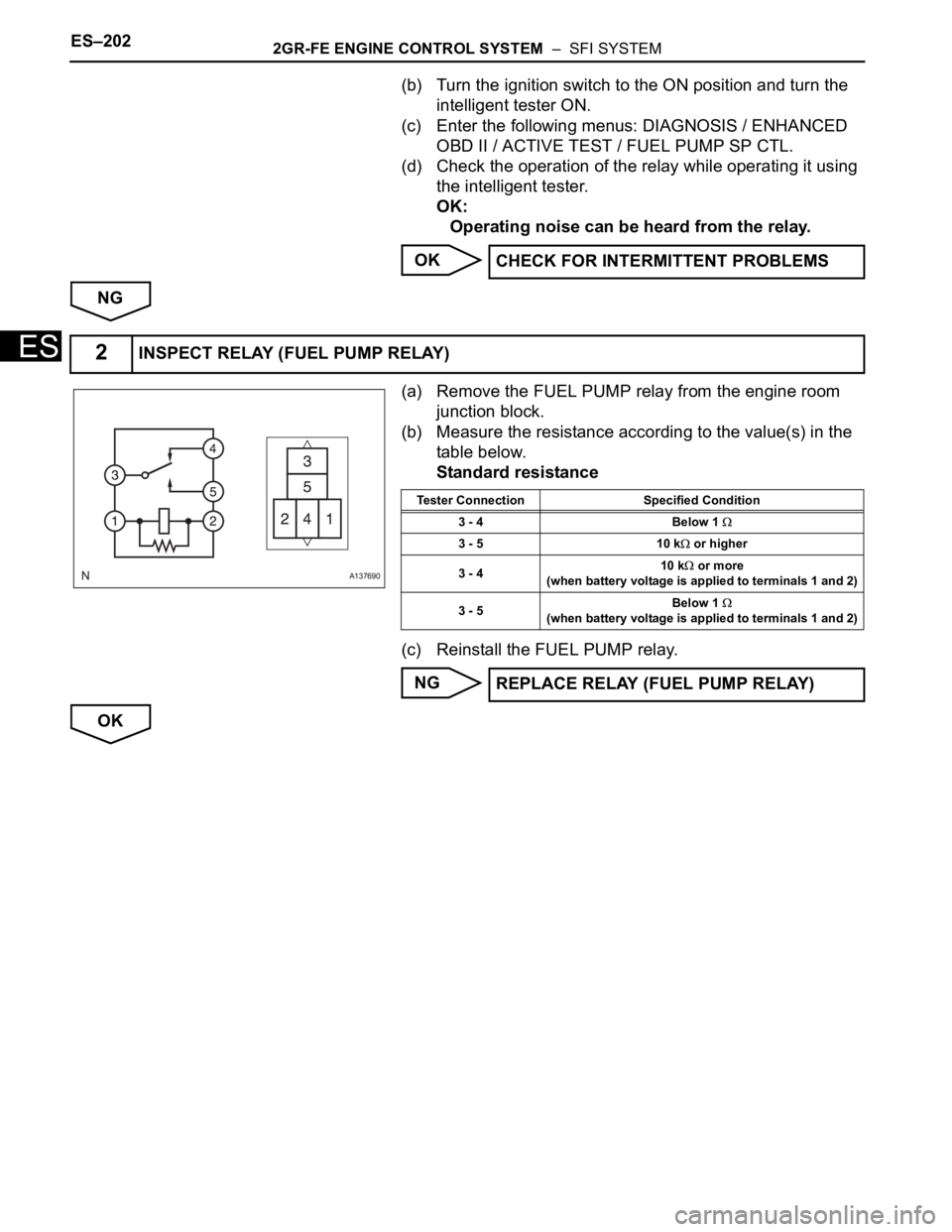
ES–2022GR-FE ENGINE CONTROL SYSTEM – SFI SYSTEM
ES
(b) Turn the ignition switch to the ON position and turn the
intelligent tester ON.
(c) Enter the following menus: DIAGNOSIS / ENHANCED
OBD II / ACTIVE TEST / FUEL PUMP SP CTL.
(d) Check the operation of the relay while operating it using
the intelligent tester.
OK:
Operating noise can be heard from the relay.
OK
NG
(a) Remove the FUEL PUMP relay from the engine room
junction block.
(b) Measure the resistance according to the value(s) in the
table below.
Standard resistance
(c) Reinstall the FUEL PUMP relay.
NG
OKCHECK FOR INTERMITTENT PROBLEMS
2INSPECT RELAY (FUEL PUMP RELAY)
A137690
Tester Connection Specified Condition
3 - 4 Below 1
3 - 5 10 k or higher
3 - 410 k
or more
(when battery voltage is applied to terminals 1 and 2)
3 - 5Below 1
(when battery voltage is applied to terminals 1 and 2)
REPLACE RELAY (FUEL PUMP RELAY)
Page 509 of 3000
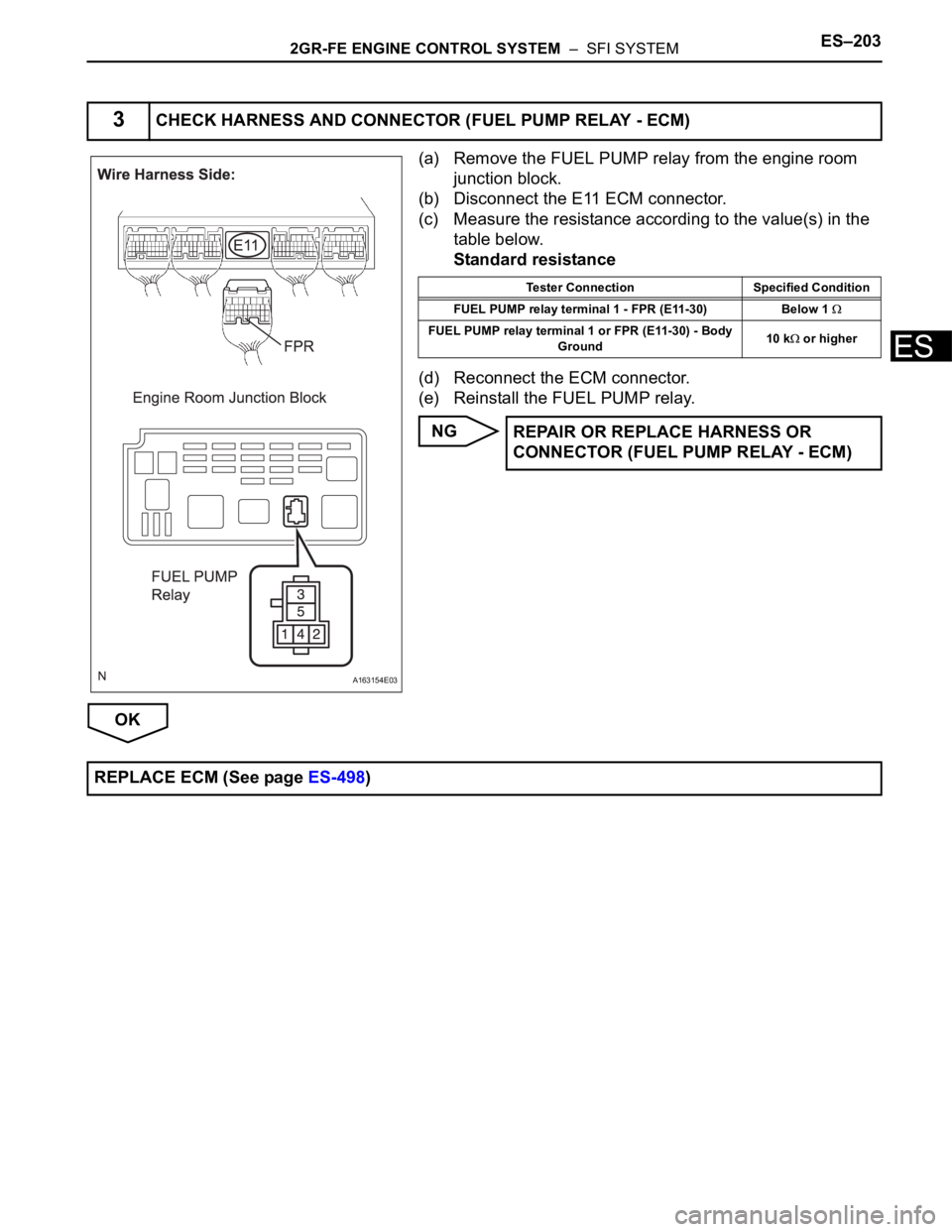
2GR-FE ENGINE CONTROL SYSTEM – SFI SYSTEMES–203
ES
(a) Remove the FUEL PUMP relay from the engine room
junction block.
(b) Disconnect the E11 ECM connector.
(c) Measure the resistance according to the value(s) in the
table below.
Standard resistance
(d) Reconnect the ECM connector.
(e) Reinstall the FUEL PUMP relay.
NG
OK
3CHECK HARNESS AND CONNECTOR (FUEL PUMP RELAY - ECM)
A163154E03
Tester Connection Specified Condition
FUEL PUMP relay terminal 1 - FPR (E11-30) Below 1
FUEL PUMP relay terminal 1 or FPR (E11-30) - Body
Ground10 k or higher
REPAIR OR REPLACE HARNESS OR
CONNECTOR (FUEL PUMP RELAY - ECM)
REPLACE ECM (See page ES-498)
Page 510 of 3000
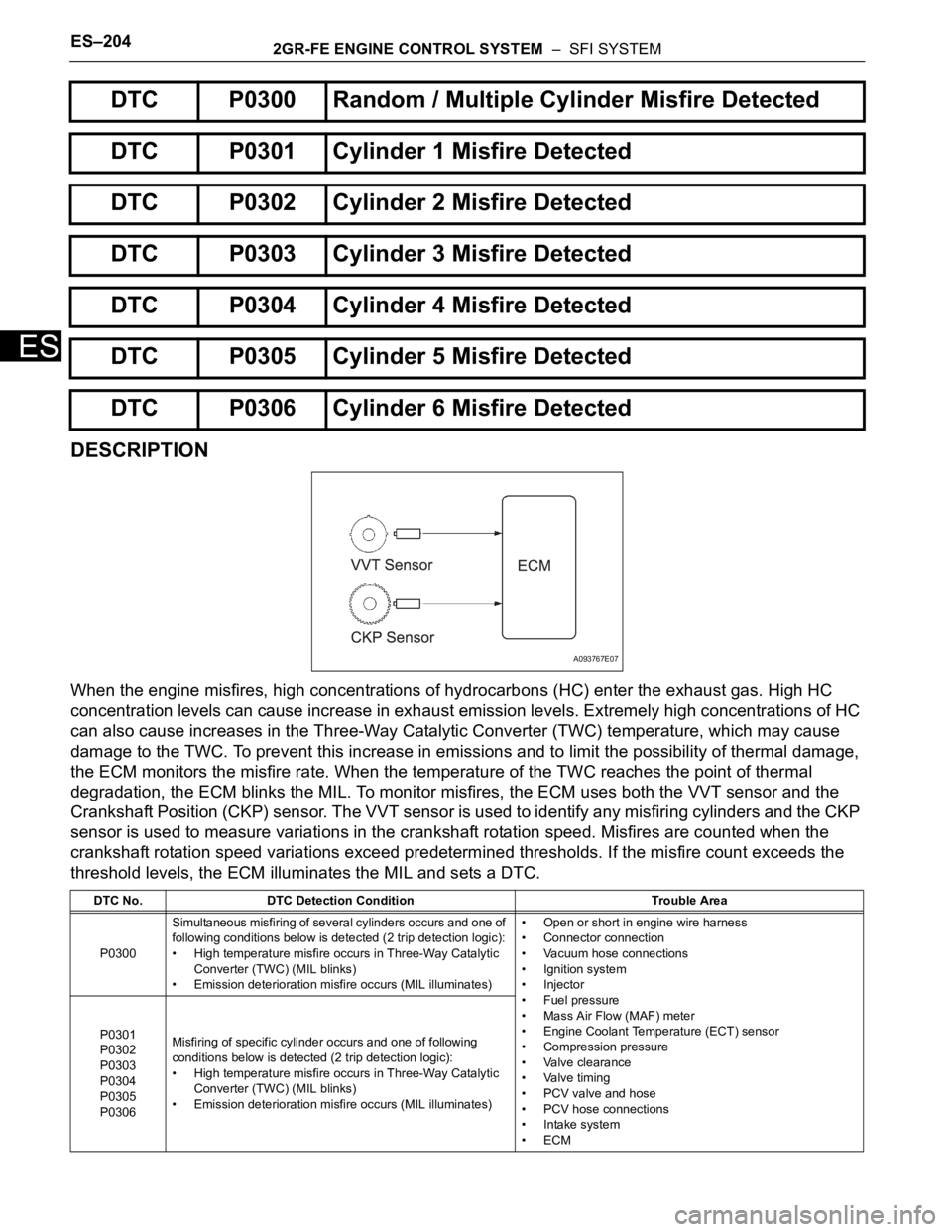
ES–2042GR-FE ENGINE CONTROL SYSTEM – SFI SYSTEM
ES
DESCRIPTION
When the engine misfires, high concentrations of hydrocarbons (HC) enter the exhaust gas. High HC
concentration levels can cause increase in exhaust emission levels. Extremely high concentrations of HC
can also cause increases in the Three-Way Catalytic Converter (TWC) temperature, which may cause
damage to the TWC. To prevent this increase in emissions and to limit the possibility of thermal damage,
the ECM monitors the misfire rate. When the temperature of the TWC reaches the point of thermal
degradation, the ECM blinks the MIL. To monitor misfires, the ECM uses both the VVT sensor and the
Crankshaft Position (CKP) sensor. The VVT sensor is used to identify any misfiring cylinders and the CKP
sensor is used to measure variations in the crankshaft rotation speed. Misfires are counted when the
crankshaft rotation speed variations exceed predetermined thresholds. If the misfire count exceeds the
threshold levels, the ECM illuminates the MIL and sets a DTC.
DTC P0300 Random / Multiple Cylinder Misfire Detected
DTC P0301 Cylinder 1 Misfire Detected
DTC P0302 Cylinder 2 Misfire Detected
DTC P0303 Cylinder 3 Misfire Detected
DTC P0304 Cylinder 4 Misfire Detected
DTC P0305 Cylinder 5 Misfire Detected
DTC P0306 Cylinder 6 Misfire Detected
DTC No. DTC Detection Condition Trouble Area
P0300Simultaneous misfiring of several cylinders occurs and one of
following conditions below is detected (2 trip detection logic):
• High temperature misfire occurs in Three-Way Catalytic
Converter (TWC) (MIL blinks)
• Emission deterioration misfire occurs (MIL illuminates)• Open or short in engine wire harness
• Connector connection
• Vacuum hose connections
• Ignition system
• Injector
• Fuel pressure
• Mass Air Flow (MAF) meter
• Engine Coolant Temperature (ECT) sensor
• Compression pressure
• Valve clearance
• Valve timing
• PCV valve and hose
• PCV hose connections
• Intake system
•ECM P0301
P0302
P0303
P0304
P0305
P0306Misfiring of specific cylinder occurs and one of following
conditions below is detected (2 trip detection logic):
• High temperature misfire occurs in Three-Way Catalytic
Converter (TWC) (MIL blinks)
• Emission deterioration misfire occurs (MIL illuminates)
A093767E07